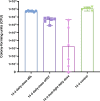Dual-light photodynamic therapy administered daily provides a sustained antibacterial effect on biofilm and prevents Streptococcus mutans adaptation
- PMID: 32374766
- PMCID: PMC7202659
- DOI: 10.1371/journal.pone.0232775
Dual-light photodynamic therapy administered daily provides a sustained antibacterial effect on biofilm and prevents Streptococcus mutans adaptation
Abstract
Antibacterial photodynamic therapy (aPDT) and antibacterial blue light (aBL) are emerging treatment methods auxiliary to mechanical debridement for periodontitis. APDT provided with near-infrared (NIR) light in conjunction with an indocyanine green (ICG) photosensitizer has shown efficacy in several dental in-office-treatment protocols. In this study, we tested Streptococcus mutans biofilm sensitivity to either aPDT, aBL or their combination dual-light aPDT (simultaneous aPDT and aBL) exposure. Biofilm was cultured by pipetting diluted Streptococcus mutans suspension with growth medium on the bottom of well plates. Either aPDT (810 nm) or aBL (405 nm) or a dual-light aPDT (simultaneous 810 nm aPDT and 405 nm aBL) was applied with an ICG photosensitizer in cases of aPDT or dual-light, while keeping the total given radiant exposure constant at 100 J/cm2. Single-dose light exposures were given after one-day or four-day biofilm incubations. Also, a model of daily treatment was provided by repeating the same light dose daily on four-day and fourteen-day biofilm incubations. Finally, the antibacterial action of the dual-light aPDT with different energy ratios of 810 nm and 405 nm of light were examined on the single-day and four-day biofilm protocols. At the end of each experiment the bacterial viability was assessed by colony-forming unit method. Separate samples were prepared for confocal 3D biofilm imaging. On a one-day biofilm, the dual-light aPDT was significantly more efficient than aBL or aPDT, although all modalities were bactericidal. On a four-day biofilm, a single exposure of aPDT or dual-light aPDT was more efficient than aBL, resulting in a four logarithmic scale reduction in bacterial counts. Surprisingly, when the same amount of aPDT was repeated daily on a four-day or a fourteen-day biofilm, bacterial viability improved significantly. A similar improvement in bacterial viability was observed after repetitive aBL application. This viability improvement was eliminated when dual-light aPDT was applied. By changing the 405 nm to 810 nm radiant exposure ratio in dual-light aPDT, the increase in aBL improved the antibacterial action when the biofilm was older. In conclusion, when aPDT is administered repeatedly to S. mutans biofilm, a single wavelength-based aBL or aPDT leads to a significant biofilm adaptation and increased S. mutans viability. The combined use of aBL light in synchrony with aPDT arrests the adaptation and provides significantly improved and sustained antibacterial efficacy.
Conflict of interest statement
We have a financial disclosure about the paper, including authors, Sakari Nikinmaa, Tommi Pätilä and Juha Rantala. These authors are shareholders in a company Koite Health Oy, where SN and TP are also members of the board. Koite Health has filed patents P21233F100 and P22769F100, which are related to antibacterial dual light. The company Koite Health is developing a dual light antibacterial product for prevention of dental infections. Martti Vaara is a shareholder and a board member in Northern Antibiotics INC, which is dedicated to developing novel Colistin antibiotics. This financial disclosure does not alter our adherence to PLOS ONE policies on sharing data and materials.
Figures







Similar articles
-
Antimicrobial photodynamic therapy of S. mutans biofilms attached to relevant dental materials.Lasers Surg Med. 2016 Dec;48(10):995-1005. doi: 10.1002/lsm.22534. Epub 2016 Jun 1. Lasers Surg Med. 2016. PMID: 27252025
-
Daily Administered Dual-Light Photodynamic Therapy Provides a Sustained Antibacterial Effect on Staphylococcus aureus.Antibiotics (Basel). 2021 Oct 13;10(10):1240. doi: 10.3390/antibiotics10101240. Antibiotics (Basel). 2021. PMID: 34680821 Free PMC article.
-
Effect of methylene blue-induced photodynamic therapy on a Streptococcus mutans biofilm model.Photodiagnosis Photodyn Ther. 2017 Dec;20:234-237. doi: 10.1016/j.pdpdt.2017.10.025. Epub 2017 Oct 31. Photodiagnosis Photodyn Ther. 2017. PMID: 29101088
-
Effect of curcumin-mediated photodynamic therapy on Streptococcus mutans and Candida albicans: A systematic review of in vitro studies.Photodiagnosis Photodyn Ther. 2019 Sep;27:455-461. doi: 10.1016/j.pdpdt.2019.07.010. Epub 2019 Jul 25. Photodiagnosis Photodyn Ther. 2019. PMID: 31352059
-
Light therapy: complementary antibacterial treatment of oral biofilm.Adv Dent Res. 2012 Sep;24(2):103-7. doi: 10.1177/0022034512449469. Adv Dent Res. 2012. PMID: 22899690 Review.
Cited by
-
Home-Applied Dual-Light Photodynamic Therapy in the Treatment of Stable Chronic Periodontitis (HOPE-CP)-Three-Month Interim Results.Dent J (Basel). 2022 Nov 2;10(11):206. doi: 10.3390/dj10110206. Dent J (Basel). 2022. PMID: 36354651 Free PMC article.
-
Simultaneous Dual-Wavelength Laser Irradiation against Implant-Adherent Biofilms of Staphylococcus aureus, Escherichia coli, and Candida albicans for Improved Antimicrobial Photodynamic Therapy.Bioengineering (Basel). 2024 Jan 2;11(1):48. doi: 10.3390/bioengineering11010048. Bioengineering (Basel). 2024. PMID: 38247925 Free PMC article.
-
Evaluation of antimicrobial photodynamic therapy with acidic methylene blue for the treatment of experimental periodontitis.PLoS One. 2022 Feb 10;17(2):e0263103. doi: 10.1371/journal.pone.0263103. eCollection 2022. PLoS One. 2022. PMID: 35143492 Free PMC article.
-
Antimicrobial photodynamic therapy for the treatment of oral infections: A systematic review.J Dent Sci. 2023 Oct;18(4):1453-1466. doi: 10.1016/j.jds.2023.07.002. Epub 2023 Jul 11. J Dent Sci. 2023. PMID: 37799910 Free PMC article. Review.
-
Quorum quenching of Streptococcus mutans via the nano-quercetin-based antimicrobial photodynamic therapy as a potential target for cariogenic biofilm.BMC Microbiol. 2022 May 10;22(1):125. doi: 10.1186/s12866-022-02544-8. BMC Microbiol. 2022. PMID: 35538403 Free PMC article.
References
-
- Claydon NC. Current concepts in toothbrushing and interdental cleaning. Available: http://168.176.239.58/cursos/odontologia/2016549/pdf/Claydon2008Cepillad... - PubMed
MeSH terms
Substances
LinkOut - more resources
Full Text Sources
Medical
Molecular Biology Databases
Miscellaneous

